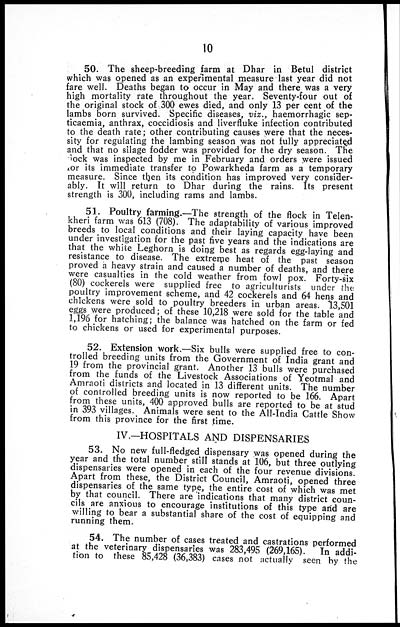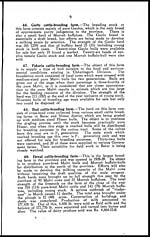Medicine - Veterinary > Civil Veterinary Departments > 1925-1941 - Report on the working of the Civil Veterinary Department of the Central Provinces and Berar > 1932-1941 - Civil Veterinary Department. Central Provinces & Berar 1932-41 > Annual report on the working of the Civil Veterinary Department in the Central Provinces & Berar for the year ending the 31st March 1940
(320) Page 10
Download files
Individual page:
Thumbnail gallery: Grid view | List view

10
50. The sheep-breeding farm at Dhar in Betul district
which was opened as an experimental measure last year did not
fare well. Deaths began to occur in May and there was a very
high mortality rate throughout the year. Seventy-four out of
the original stock of 300 ewes died, and only 13 per cent of the
lambs born survived. Specific diseases, viz., haemorrhagic sep-
ticaemia, anthrax, coccidiosis and liverfluke infection contributed
to the death rate; other contributing causes were that the neces-
sity for regulating the lambing season was not fully appreciated
and that no silage fodder was provided for the dry season. The
lock was inspected by me in February and orders were issued
for its immediate transfer to Powarkheda farm as a temporary
measure. Since then its condition has improved very consider-
ably. It will return to Dhar during the rains. Its present
strength is 300, including rams and lambs.
51. Poultry farming.—The strength of the flock in Telen-
kheri farm was 613 (708). The adaptability of various improved
breeds to local conditions and their laying capacity have been
under investigation for the past five years and the indications are
that the white Leghorn is doing best as regards egg-laying and
resistance to disease. The extreme heat of the past season
proved a heavy strain and caused a number of deaths, and there
were casualties in the cold weather from fowl pox. Forty-six
(80) cockerels were supplied free to agriculturists under the
poultry improvement scheme, and 42 cockerels and 64 hens and
chickens were sold to poultry breeders in urban areas. 13,501
eggs were produced; of these 10,218 were sold for the table and
1,196 for hatching; the balance was hatched on the farm or fed
to chickens or used for experimental purposes.
52. Extension work.—Six bulls were supplied free to con-
trolled breeding units from the Government of India grant and
19 from the provincial grant. Another 13 bulls were purchased
from the funds of the Livestock Associations of Yeotmal and
Amraoti districts and located in 13 different units. The number
of controlled breeding units is now reported to be 166. Apart
from these units, 400 approved bulls are reported to be at stud
in 393 villages. Animals were sent to the All-India Cattle Show
from this province for the first time.
IV.—HOSPITALS AND DISPENSARIES
53. No new full-fledged dispensary was opened during the
year and the total number still stands at 106, but three outlying
dispensaries were opened in each of the four revenue divisions.
Apart from these, the District Council, Amraoti, opened three
dispensaries of the same type, the entire cost of which was met
by that council. There are indications that many district coun-
cils are anxious to encourage institutions of this type and are
willing to bear a substantial share of the cost of equipping and
running them.
54. The number of cases treated and castrations performed
at the veterinary dispensaries was 283,495 (269,165). In addi-
tion to these 85,428 (36,383) cases not actually seen by the
Set display mode to: Large image | Zoom image | Transcription
Images and transcriptions on this page, including medium image downloads, may be used under the Creative Commons Attribution 4.0 International Licence unless otherwise stated. ![]()
| Permanent URL | https://digital.nls.uk/75696478 |
|---|




